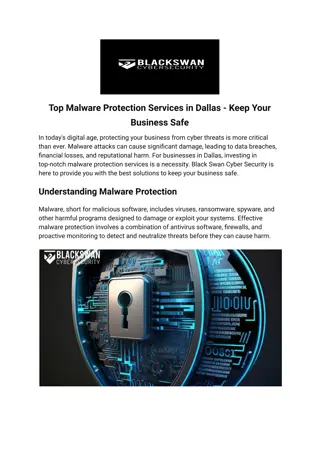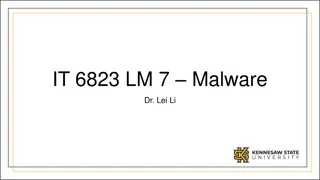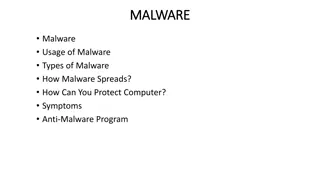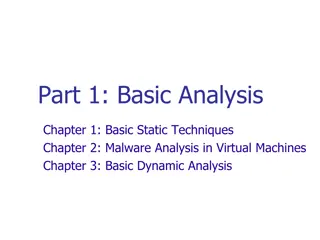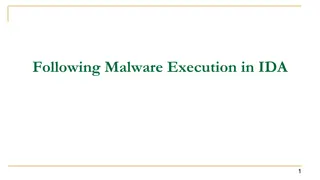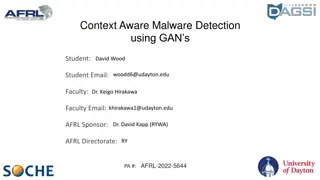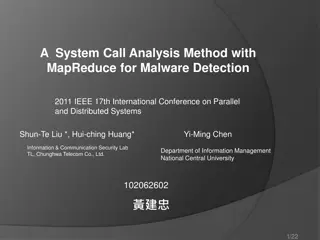Insight into FinFisher Malware Suite
FinFisher is a malware suite developed by Gamma International, offering a range of intelligence-gathering tools such as keylogging, webcam and microphone recording, and remote file access. The suite includes components like the FinSpy remote Windows spying tool and the FinFisher Master Server for executing targeted attacks. This malicious software is often distributed through email communications and USB devices, targeting entities such as intelligence agencies and government organizations.
Download Presentation

Please find below an Image/Link to download the presentation.
The content on the website is provided AS IS for your information and personal use only. It may not be sold, licensed, or shared on other websites without obtaining consent from the author.If you encounter any issues during the download, it is possible that the publisher has removed the file from their server.
You are allowed to download the files provided on this website for personal or commercial use, subject to the condition that they are used lawfully. All files are the property of their respective owners.
The content on the website is provided AS IS for your information and personal use only. It may not be sold, licensed, or shared on other websites without obtaining consent from the author.
E N D
Presentation Transcript
The FinFisher Malware Suite A quick breakdown by Joe Giron
The hell is FinFisher? FinFisher suite of malware tools that belongs to a UK company known as Gamma International (formerly GammaGroup). The company produces spyware, exploits, and a slue of other intelligence gathering tools. Their clientele include intelligence agencies, law enforcement, government entities, and foreign regimes. Today we will be looking at FinSpy the remote windows spying component.
Capabilities Certificate based encryption Remote File Access Key-logging Password Sniffing Webcam Recording Microphone Recording Local Passwords Theft E-Mail Dumping Chat Logging (MSN, ICQ, IRC and Skype) Geo-Location Generic system information collection Remote Command Shell Capabilities
FinFisher Master Server Fairly simple config. Set the proxy server for listening, set the ports, certs, etc. The master server comes with a few windows exes (next slide) for attaching a target jpeg, mp3, word doc, or whatever to your exe.
FinFisher Master Server p2 The server when installed has a TargetModules directory that contains a few executables. The buildx.exe file is a hollow skeleton of the binary I m about go over (FinSpy). bundledoc.exe will bind a document file (word, spreadsheet, pdf, image, mp3, etc) to the trojan so that when the trojan is run, this file is launched afterwards to lower suspicions. The resources sections of all 3 binaries contain the decrypted loaders and rootkit, but that s kind of cheating.
FinFisher Proxy The FinFisher Proxy server accepts SSL connections from ports 22, 25, 53, 80, 443, and 4111. It communicates with the master server over port 9118. I guess that s one IOC to watch for HTTPS traffic on ports other than 80/443. The config is pretty simple too set ports, set log file, set networking device. That s it!
How does it infect? Email communications. The files have jpeg icons to fool users. They are sent as attachments. Given the picture of Iran s president, I m inclined to believe the intended audience is politically motivated. They probably make use of the Right- To-Left character (unicode 202E) to shift the extension to the left. On a unicode enabled client, it would make the file show up as exe.NotAVirus.jpg . Thumb Drives / dongles. The SpyFiles documentation gathered on Gamma International show a tool called FinFly which makes use of dongles for plug and play exploitation assuming physical access is possible.
How does it communicate? SSL encrypted streams. After rootkit infection, the malware spawns a legit system process, hollows it out and injects a dll into it which then communicates with the FinProxy server which in turn sends its data to the master server.
What happens after launch? It loads that picture you saw at in the first slide. It then loads a rootkit and chills secretly stealing your data. Among other things, it hooks the System Service Dispatcher Table and hides itself from traditional dumping.
Details pls! FinSpy uses process hollowing as a means to inject itself another processes to run its code. This is where you spawn a legit process like say svchost.exe suspended, allocate some space, write your evil code inside with WriteProcessMemory(), duplicate any handles you had before, get the original program s main thread context, then set the main thread s context of the newly spawned process and BAM now it appears as though svchost.exe is doing the evil deed instead of the original binary. In FinSpy s case, it copies itself into the temp folder, then performs this process hollowing technique against its own copy and runs that copy before exiting.
Moar Details pls! After running itself from the temp folder, the malware decrypts its modules stored in its resources sections(more on that next). The resource when decrypted contains the second dropper which is responsible for dropping the rootkit and also includes anti-sandboxing code. The rootkit is also stored in the resources section as a dialog. Hope I didn t lose you there. Here s a crude representation: [exe<.rsrc>] [exe<.rsrc>] [rootkit]
Encryption / Decryption Oh My! Every module used by FinSpy is stored in the resources section and encrypted by a 4 byte key. That key is 5F 1E CA 67. Extraction is easy with Python:
Same Xor Key? REALLY??? I have proof that the one leaked in 2012 is similar to the one dropped in September. The file md5 is different, but the XOR key for decryption of the dropper module is the same. According to https://citizenlab.org/2012/07/from- bahrain-with-love-finfishers-spy-kit- exposed/ the XOR key used for decryption of modules is the same. This makes sense since the brochure said every exe is changed to avoid AV detection, but apparently not changed very much.
Am In in A sandbox? FinSpy includes sandbox detection via Structed Exception Handling. It writes a few bytes (call to the rootkit dropper) into the function KiUserExceptionDispatcher, then triggers an exception using the opcode ud2 . When an SEH kicks in windows calls the bytes replaces in the exception dispatcher function. It does this 3 times. The idea is that a sandbox will just see the app crashed several times and give up. FYI, putting the ASM for this in PP sucks. It wont fit. Take my word for it. And the HexRays code is even worse:
Rewt Kit After decryption, sandbox checks, and generally making my reversing life miserable, FinSpy drops a rootkit. The rootkit modifies your MBR (BAD) to hook INT13 calls. INT13 is responsible for disk reads. This allows the malware procmon functionality by going as low as possible. AV s don t go this low. Every time a disk read is performed, it spawns a new thread for logging and acquisition. You wont be able to see it on disk as its memory resident, however before it goes memory resident you WILL see a new service created with the name mssoundx with the driver named driverw.sys In fact, it s a real pain to detect period. The one thing that stands out though is how the rootkit initializes data logging it spawns a system process that s auto- launched after killing. Example on my win7 64 VM, it kept loading explorer.exe from the syswow64 folder instead of the windows directory and would come back immediately after killing.
Data Theft It grabs everything it can including keystrokes, geo location, microphone & webcam surveillance, skype monitoring, email logging, and more. The data is encrypted with 256 bit AES and stored in the same directory as where the rootkit was first stored the %windir%\Installer folder. It will send your data to the Finproxy of your choice which then sends back to the FinMaster server for handling.
How do we detect it? Pre-op - Yara rules Postmortem RootRepeal, GMER, presence of files in the installer directory since that s where it stores its intercepted data. Don t trust email Force the show extensions for known file types setting in Windows.
YARA Detection rule finfisher : lolwut { meta: description = "Joes FinSpy rule strings: $a = {67 CA 1E 5F} condition: $a }
Unique Tricks This threw me off for about 20 minutes. The app launches when CreateWindowExW is called, but it actually calls CreateProcessW. It does this by re-writing the address of CreateWindowExW with CreateProcessW. So when my debugger sets a breakpoint on CreateProcess, nothing happens. Thank god for IDA.
Final Thoughts This was some advanced stuff. Unlike traditional malware which mostly falls under the written while bored on a Sunday category, there s money behind it. As a result, its far more advanced than what one typically runs into on the net. FinSpy isn t fool proof. You ll be able to see it with conventional anti-rootkit tools like RootRepeal and GMER. If you have an anti-malware appliance that supports YARA, you can pick it out of the line-up. Those of us without that fancy stuff will have to rely on the usual techniques (not being stupid) to avoid infection.
Works Cited WikiLeaks produced a document a few years back titled SpyFiles https://www.wikileaks.org/the-spyfiles.html I did a lot of work on this, but codeandsec beat me to it in his analysis https://www.codeandsec.com/FinFisher- Malware-Dropper-Analysis These 2 gentlemen beat us both with their analysis of the exe in 2012 https://finfcuker.wordpress.com/2012/08/ https://citizenlab.org/2012/07/from-bahrain-with- love-finfishers-spy-kit-exposed/



